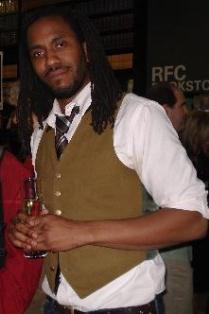 CHICAGO (AP) -- For more than a decade, contemporary artist Rashid Johnson has worked almost under the radar, turning out work presented at museums and coveted by collectors around the world.
CHICAGO (AP) -- For more than a decade, contemporary artist Rashid Johnson has worked almost under the radar, turning out work presented at museums and coveted by collectors around the world.
But in the last year, the Chicago native, whose works made from everyday objects explore his own life story as well as larger issues of black identity, has garnered high-profile attention and awards from the art world. This month he opens his first major solo exhibition at the Museum of Contemporary Art in Chicago.
"A lot of eyes are on him right now," said Julie Rodrigues Widholm, curator of "Rashid Johnson: Message to Our Folks."
"He's an artist who has been working for 14 years and has never had a major solo exhibition," she said. "We really felt because of that absence it was time."
That timing is excellent. In the last year, Johnson has been included in the prestigious International Art Exhibition of the Venice Biennale, was named a 2012 nominee for the Guggenheim Museum's Hugo Boss Prize and won the High Museum's David C. Driskell prize that honors African-American art and scholarship.
The attention is appreciated, Johnson said, but he's more interested in the discourse and dialogue around his work. "When there's a giant buzz about you, you're the last person to know," he said during an interview.
Johnson, who now works in New York, uses everyday materials - everything from books to mirrors to shea butter to plants - to create sculptures that reflect his own life story while exploring the black experience. In a video on the museum website, he recalls growing up "enveloped in this Afrocentric conversation. We celebrated Kwanzaa, my mother wore dashikis." Then "one day they weren't wearing dashikis anymore," he said. He uses art and humor to explore "that transition from Afrocentrism" to "your parents becoming middle-class soccer moms."
The Chicago exhibition spans Johnson's body of work, emphasizing the last five years. It includes references to major African-American cultural figures and influences, like W.E.B. DuBois, Miles Davis and Public Enemy, and consists of a variety of media, including photography, video, sculpture and paintings.
Johnson describes himself as a middle-class black kid growing up in the Chicago-area, interested in graffiti, theater and photography. His work, he said, often times is autobiographical.
"It's an introduction to people of a different black experience," Johnson said.
Widholm sees several themes running through Johnson's work, but focuses on identity.
"He is making work that is personal to counteract the expectation of a black artist speaking for all black artists," she said. "His references and his work allude to artists, musicians, political figures, sports figures, who in one way or another stepped outside of tradition."
His future, Widholm said, is bright.
"I'm really excited to see how his work creates dialogue in different contexts," she said. "There's no limit really to what he can accomplish artistically."
The title, "Message to Our Folks," is taken from a 1969 avant-garde album in which musicians used found objects to make percussion and redefine jazz.
The exhibition is in Chicago through Aug. 5. It will travel to the Miami Art Museum, the High Museum of Art in Atlanta and the Kemper Art Museum in St. Louis.
---
If You Go...
RASHID JOHNSON: MESSAGE TO OUR FOLKS: At Museum of Contemporary Art, Chicago, through Aug. 5; 220 E. Chicago Ave., http://www.mcachicago.org or 312-280-2660. Tuesday, 10 a.m.-8 p.m.; Wednesday-Sunday, 10 a.m.-5 p.m. Suggested admission, $12.
© 2012 The Associated Press. All rights reserved. This material may not be published, broadcast, rewritten or redistributed. Learn more about our Privacy Policy and Terms of Use.
- Home
- News
- Opinion
- Entertainment
- Classified
- About Us
 MLK Breakfast
MLK Breakfast- Community
- Foundation
- Obituaries
- Donate
11-25-2024 5:06 am • PDX and SEA Weather












































































































































































































































































































